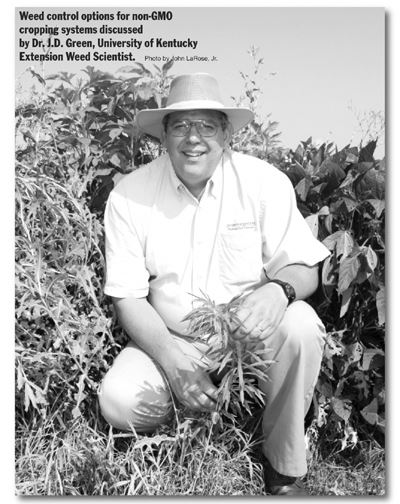Non-GMO Weed Control
Tank Mix Products To Provide Broad Spectrum Weed Control
PRINCETON, KY
Weed control options for non-GMO cropping systems was a topic discussed by Dr. J.D. Green, University of Kentucky extension weed scientist, recently. He also addressed other general weed management principles.
“When selecting a weed control program we need to be sure it’s effective on the weed species that we’re trying to manage and control,” he said. “It is important that programs are fairly easy to use as well as they must be economically viable within the system that we’re managing those weed problems.”
The level of management needed for effective weed control tends to be higher in a non-GMO program. Growers must make sure they’re paying attention to their specific weed problems and that sometimes means tank mixing two or more products together to get the same broad spectrum of control that we have come to expect with some of the GMO technologies.
“Typically, the most consistent weed control that we see is using a soil- applied followed by a post-emergence herbicide program,” Green said. “Effective weed control programs also result in optimum yields based on research through the years. The most consistent highyielding crops are obtained when we use a soil residual followed by a post emergence program.”
On the other side of the spectrum farmers must think about choosing between planting GMO seed because of weed resistance. Any time one relies on one herbicide technology, there is a higher potential for weed resistance to occur.
“We saw that back in the 1980s and early 1990s when ALS chemistries were the predominant herbicide programs for soybeans,” he explained. “In less than five years a farmer using products like Pursuit, Scepter, Canopy, and Classic had to deal with weed resistance. Now we’re talking about and are concerned about resistant weeds from over use of glyphosate, with the Roundup Ready technology program.”

Timing of herbicide applications is one of the most important factors in either GMO or non-GMO crops. If we wait five weeks or so before we make that first herbicide application we could be loosing five to 10 percent of our yield,” he said. “In fact, I’m not so sure a lot of producers aren’t loosing yield because they want to make sure all the weeds are up and emerged before they make that first application. So it’s a trade off between spraying weeds at an optimum size of three to six inches, let’s say in soybeans, versus trying to control them all later on.
“If we use an at planting soil-residual type herbicide we can typically minimize the problem and get good control early; then we shift the need for the post application later into the season.”
One of the primary benefits of soil residual herbicides is that growers can obtain more consistent season-long weed control, and also have more flexibility in making post applications in seasons like this past year when we received excessive rainfall. There have been fewer days and less opportunities to be timely in making postemergence herbicide applications this season.
“Using a soil residual herbicide allows one to use different herbicide modes of action and minimize the potential for weed resistance to occur,” Green said. “I’m not so sure that in some crop fields where good weed control has been achieved for the last few years that a good soil residual herbicide program may be all that is needed. The weed seed bank has been reduced to where weeds can be effectively managed with a soil residual herbicide treatment.”
There are a variety of different soil applied herbicides that can be used in soybeans. Whether it is something that targets broadleaf weeds or mostly grasses, several options are available. A group of other products are available for an over-the-top treatment later, if needed.
“As I mentioned earlier, we may need to tank mix some products together depending on what the specific weed problems are, but you certainly need to know your fields if you’re going to use that as your total focus for weed control,” Green said.
He noted the overall cost of weed management has changed.
“In the past, we primarily thought about only the cost of herbicides when we talked about overall weed control costs,” he explained. “In today’s world with the technology cost associated with the seed traits that are available to us, certainly we pay a premium for those seed traits; it’s not just for the weed management part of it but there’s an additional cost when we use a GMO technology that we need to account for in calculating total cost of weed management. If you look at the cost of the technology with the seed trait included it can be somewhat comparable to the total cost of a non-GMO program. The bigger difference or what can be a difference is the overall level of management I talked about earlier.”
In summary, Green said an effective weed control program is one that provides broad spectrum weed control; he also urged farmers to avoid reliance on one weed control program to minimize weed resistance.
“We should try to make herbicide applications as timely as we can since we want to ensure that we have an economically feasible, and viable weed control program,” he summed. Δ
BETTY VALLE GEGG-NAEGER: Senior Staff Writer, MidAmerica Farmer Grower